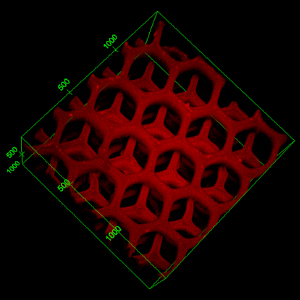Bioprinted 3D liver-mimicking device detoxifies blood
May 16, 2014

Nanoengineers have developed a 3D-printed device inspired by the liver to remove dangerous toxins from the blood. The device, which is designed to be used outside the body like dialysis, uses nanoparticles to trap pore-forming toxins that can damage cellular membranes and are a key factor in illnesses that result from animal bites and stings, and bacterial infections. (Credit: UCSD)
Nanoengineers at the University of California, San Diego have developed a 3D-printed device inspired by the liver to remove dangerous toxins from the blood.
The device, which is designed to be used outside the body — much like dialysis — uses nanoparticles to trap pore-forming toxins that can damage cellular membranes and are a key factor in illnesses that result from animal bites and stings, and bacterial infections.
The findings were published May 8 in the journal Nature Communications (open access).
Nanoparticles have already been shown to be effective at neutralizing pore-forming toxins in the blood, but if those nanoparticles cannot be effectively digested, they can accumulate in the liver creating a risk of secondary poisoning, especially among patients who are already at risk of liver failure.
To solve this problem, a research team led by nanoengineering professor Shaochen Chen created a 3D-printed hydrogel matrix to house nanoparticles, forming a device that mimics the function of the liver by sensing, attracting and capturing toxins routed from the blood.
The device, which is in the proof-of-concept stage, mimics the structure of the liver but has a larger surface area designed to efficiently attract and trap toxins within the device. In an in vitro (lab) study, the device completely neutralized pore-forming toxins.
“One unique feature of this device is that it turns red when the toxins are captured,” said the co-first author, Xin Qu, who is a postdoctoral researcher working in Chen’s laboratory. “The concept of using 3D printing to encapsulate functional nanoparticles in a biocompatible hydrogel is novel,” said Chen. “This will inspire many new designs for detoxification techniques since 3D printing allows user-specific or site-specific manufacturing of highly functional products,” Chen said.

Bio-inspired 3D detoxification device: polydiacetylene (PDA)PDA nanoparticles (green) are installed in poly(ethylene glycol) diacrylate (PEGDA) hydrogel matrix (gray) with liver-mimetic 3D structure fabricated by 3D printing. The nanoparticles attract, capture and sense toxins (red), while the 3D matrix with modified liver lobule structure allows toxins to be trapped efficiently. This biomimetic 3D detoxifier has promising clinical application for detoxification by collecting and removing toxins. (Credit: Maling Gou et al., Nature Communications)
Chen’s lab has already demonstrated the ability to print complex 3D microstructures, such as blood vessels, in mere seconds out of soft biocompatible hydrogels that contain living cells.
As previously reported in KurzweilAI, Chen’s biofabrication technology, called dynamic optical projection stereolithography (DOPsL), can produce the micro- and nanoscale resolution required to print tissues that mimic nature’s fine-grained details, including blood vessels, which are essential for distributing nutrients and oxygen throughout the body.
The biofabrication technique uses a computer projection system and precisely controlled micromirrors to shine light on a selected area of a solution containing photo-sensitive biopolymers and cells. This photo-induced solidification process forms one layer of solid structure at a time, but in a continuous fashion.
The technology is part of a new biofabrication technology that Chen is developing under a four-year,$1.5 million grant from the National Institutes of Health.The project is also supported in part by a grant from the National Science Foundation.
Abstract of Nature Communications paper
Rationally designed nanoparticles that can bind toxins show great promise for detoxification. However, the conventional intravenous administration of nanoparticles for detoxification often leads to nanoparticle accumulation in the liver, posing a risk of secondary poisoning especially in liver-failure patients. Here we present a liver-inspired three-dimensional (3D) detoxification device. This device is created by 3D printing of designer hydrogels with functional polydiacetylene nanoparticles installed in the hydrogel matrix. The nanoparticles can attract, capture and sense toxins, while the 3D matrix with a modified liver lobule microstructure allows toxins to be trapped efficiently. Our results show that the toxin solution completely loses its virulence after treatment using this biomimetic detoxification device. This work provides a proof-of-concept of detoxification by a 3D-printed biomimetic nanocomposite construct in hydrogel, and could lead to the development of alternative detoxification platforms.